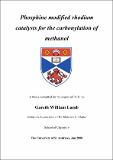Files in this item
Phosphine modified rhodium catalysts for the carbonylation of methanol
Item metadata
| dc.contributor.advisor | Clarke, Matt | |
| dc.contributor.author | Lamb, Gareth W. | |
| dc.coverage.spatial | 159 | en |
| dc.date.accessioned | 2008-12-02T16:51:14Z | |
| dc.date.available | 2008-12-02T16:51:14Z | |
| dc.date.issued | 2008-06-25 | |
| dc.identifier | uk.bl.ethos.552150 | |
| dc.identifier.uri | https://hdl.handle.net/10023/574 | |
| dc.description.abstract | The carbonylation of methanol to acetic acid is one of the most important applications in homogeneous catalysis. The first chapter comprises a review on the mechanistic studies into the catalytic cycle of the ‘Monsanto process’ and includes some of the most prominent studies into the use of phosphines in the rhodium-catalysed carbonylation of methanol. The second chapter of this thesis reports on an investigation into the application of rhodium complexes containing several C4 bridged diphosphines, namely BINAP, dppb, dppx and dcpb as catalysts for hydrogen tolerant methanol carbonylation. An investigation into the structure, reactivity and stability of pre-catalysts and catalyst resting states of these complexes has also been carried out. The origin of this hydrogen tolerance is explained based on the differing reactivities of the Rh acetyls with hydrogen gas, and by considering the structure of the complexes. In the third chapter I report on an investigation into how electronic properties and coordination mode affect the elimination of phosphonium salts from rhodium complexes. The stability of a range of monodentate, bidentate and tridentate rhodium-phosphine complexes was tested. I also report on the formation of a novel bidentate complex containing a partially quaternised TRIPHOS ligand and investigate the mechanism of formation using 13CH3I. Strong evidence is also presented supporting a dissociative mechanism as the means of phosphine loss from the rhodium centre. In the final chapters I report an investigation into the stability of rhodium-aminophosphine ligand complexes and into increasing the solubility of potential rhodium pre-catalysts through the use of amine-containing phosphine ligands. | en |
| dc.format.extent | 3193 bytes | |
| dc.format.mimetype | application/pdf | |
| dc.language.iso | en | en |
| dc.publisher | University of St Andrews | |
| dc.rights | Creative Commons Attribution-NonCommercial-NoDerivs 3.0 Unported | |
| dc.rights.uri | http://creativecommons.org/licenses/by-nc-nd/3.0/ | |
| dc.subject | Rhodium | en |
| dc.subject | Catalysis | en |
| dc.subject | Homogeneous | en |
| dc.subject | Acetic acid | en |
| dc.subject | Carbonylation | en |
| dc.subject | Methanol | en |
| dc.subject | Ethanoic acid | en |
| dc.subject | Phosphine | en |
| dc.subject | Ligand | en |
| dc.subject | Phosphorous | en |
| dc.subject | Monsanto | en |
| dc.subject | Catalyst | en |
| dc.subject.lcc | QD505.L2 | en |
| dc.subject.lcsh | Acetic acid--Synthesis | en |
| dc.subject.lcsh | Rhodium catalysts | en |
| dc.subject.lcsh | Catalysis | en |
| dc.subject.lcsh | Methanol | en |
| dc.subject.lcsh | Phosphine | en |
| dc.title | Phosphine modified rhodium catalysts for the carbonylation of methanol | en |
| dc.type | Thesis | en |
| dc.contributor.sponsor | Engineering and Physical Sciences Research Council (EPSRC) | en |
| dc.contributor.sponsor | British Petroleum Company | en |
| dc.type.qualificationlevel | Doctoral | en |
| dc.type.qualificationname | PhD Doctor of Philosophy | en |
| dc.publisher.institution | The University of St Andrews | en |
This item appears in the following Collection(s)
Except where otherwise noted within the work, this item's licence for re-use is described as Creative Commons Attribution-NonCommercial-NoDerivs 3.0 Unported
Items in the St Andrews Research Repository are protected by copyright, with all rights reserved, unless otherwise indicated.


